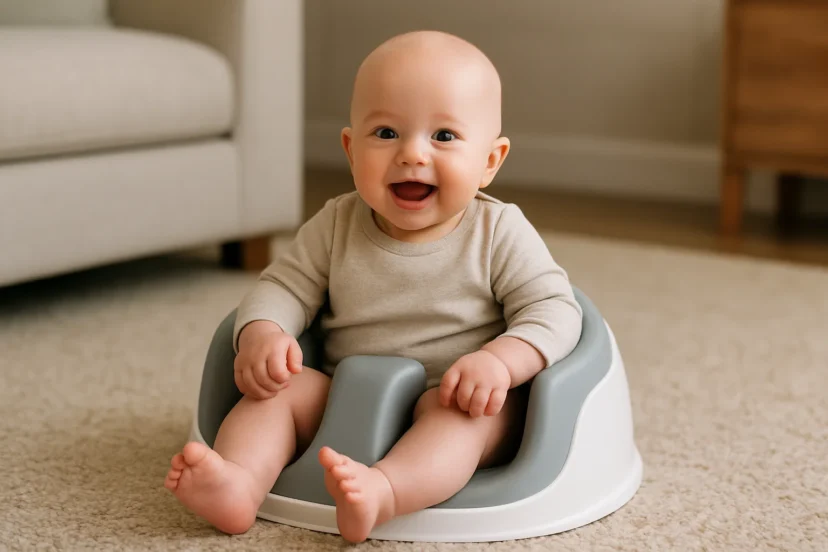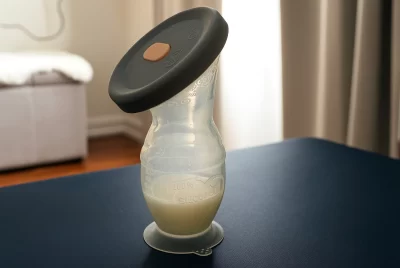Why a Baby Floor Seat is a Must-Have for New Parents
*We may earn a commission for purchases made using our links. Please see our disclosure to learn more.
When I was a first-time Mom, I clearly remember the moment I realized I needed a baby floor seat. My daughter had reached that magical age where she wanted to sit up and explore the world, but her wobbly muscles weren’t quite ready to hold her steady. With dishes piling up, emails to answer, and a desperate need for just five minutes of hands-free time, a friend suggested a baby floor seat. Honestly, it changed our daily routine in ways I never expected.
Key Takeaways
- Baby floor seats support infants who are learning to sit but aren’t quite independent
- Proper timing is crucial—most seats are appropriate for babies who have some neck control (usually around 3-4 months)
- Safety features like wide bases, secure harnesses, and proper head support are non-negotiable
- Consider versatility, portability, washability, and developmental benefits when choosing a seat
- Floor seats should be used for limited time periods (15-20 minutes) and always with adult supervision
“The right baby floor seat isn’t just about keeping your little one upright—it’s about giving them a new perspective on the world while providing you those precious moments of free hands.”
— Dr. Sarah Johnson, Pediatric Development Specialist
Top Recommended Baby Floor Seats
Based on my personal experience and extensive research, here are four outstanding baby floor seats:
1. Fisher-Price Sit-Me-Up Floor Seat
The Fisher-Price Portable Baby Chair Sit-Me-Up Floor Seat is the perfect way to help your little one sit up comfortably. With its sturdy wide base and cozy, supportive seat, this chair ensures your baby stays in an upright position safely. It also includes fun developmental toys like a clacker and a flower teether to engage your baby during playtime. For easy cleaning, the soft seat pad is removable and machine washable. Plus, it folds compactly, making it ideal for storage or travel.
- Portable & Convenient: Folds easily for space-saving storage or travel.
- Supports Baby’s Development: Comes with toys to encourage play and motor skills.
- Easy to Clean: Machine washable seat pad for quick and hassle-free maintenance.
- Weight Limit: May not support larger babies as they grow.
- Limited Recline Options: Doesn’t have adjustable recline features for different positions.
- Toys May Be Too Simple: Some parents may prefer more interactive or adjustable toys.
This lightweight, portable option provides gentle support with a wide, stable base. The removable toy bar keeps baby entertained, while the machine-washable fabric seat makes cleanup a breeze. Perfect for babies who have good head control up to sitting independently.
Why I love it: The soft-sided nature allows it to fold flat for storage or travel, making it ideal for smaller homes or visits to grandparents.
2. Infantino Music & Lights 3-in-1 Discovery Seat & Booster
The Infantino Music & Lights 3-in-1 Discovery Seat and Booster is the perfect multifunctional solution for your baby’s playtime, snack time, and dining time. This lightweight, portable seat includes engaging activities like a light-up musical piano that plays 20 sounds and songs, helping to support your baby's sensory and fine motor development. The seat converts from a fun activity chair to a snack booster, and even a table booster, making it adaptable as your child grows. The removable soft foam insert is easy to clean, and the seat is equipped with safety straps to keep your baby secure.
- Versatile Design: Can be used as a play chair, snack booster, and table booster.
- Engaging Play Features: Includes a light-up musical piano with 20 sounds and songs for sensory development.
- Easy to Clean: Wipeable surface and removable foam insert make maintenance simple.
- Limited Weight Capacity: Suitable only for babies up to 33 lbs, limiting its use as your child grows.
- Toy Tray Cannot Be Fully Removed: The toy tray stays attached in booster mode, which may be inconvenient for some.
- No Adjustable Height: The seat does not offer height adjustment for different table levels.
This versatile seat transforms from a supported floor seat to a booster seat with tray, and finally to a toddler seat. The 360° rotating toy station with lights and music provides engaging entertainment while developing fine motor skills.
Why I love it: The exceptional value of a product that truly grows with your baby from approximately 4 months to toddlerhood makes this an economical choice for budget-conscious families.
3. Bumbo Floor Seat
The Bumbo Baby Floor Seat is designed to provide excellent support for infants learning to sit, making it the perfect solution for babies aged 3 to 12 months. Its soft, durable foam ensures comfort while your little one plays, eats, or relaxes. The seat includes a secure harness system to keep your baby safe and snug. Lightweight and portable, this floor seat is easy to carry, and its high-quality construction ensures long-lasting durability. For added convenience, it can be paired with the Bumbo Play Tray (sold separately) for feeding and playtime.
- Ideal for Sitting Support: Great for babies learning to sit independently, from 3 to 12 months.
- Comfortable & Durable: Soft foam construction ensures comfort while being easy to clean.
- Portable: Lightweight design makes it easy to move from room to room or take on the go.
- Limited Age Range: Designed for babies between 3 to 12 months, so it won't last as they grow.
- Play Tray Sold Separately: Additional accessories like the play tray are not included and must be bought separately.
- Not Adjustable: The seat does not have adjustable features for varying levels of comfort or size.
The classic Bumbo seat remains popular for good reason. Its lightweight, molded foam construction cradles babies who have developed neck control but aren’t yet sitting independently. The optional tray attachment converts it into a first feeding station.
Why I love it: The simplistic design without overstimulating features makes this perfect for babies who get overwhelmed easily, while the easy-clean surface handles mealtime messes like a champion.
4. Summer Infant Learn-to-Sit 2-Position Floor Seat
The Summer Infant Learn-to-Sit 2-Position Floor Seat is designed to grow with your baby, offering two adjustable positions to accommodate different developmental stages. It features a comfy, cushioned seat that helps your little one learn to sit up, with a 3-point safety harness to keep them secure during playtime. The seat also includes removable toys that engage your baby's senses, and the entire seat folds flat for easy storage or travel. Plus, the soft fabric is machine washable for easy cleanup.
- Adjustable Positions: Offers both a reclined and upright seat for different developmental stages.
- Engaging Toys: Includes removable toys that entertain and stimulate your baby’s senses.
- Portable & Easy Storage: Folds flat for convenient storage or travel.
- Age Range Limitations: Best for babies aged 4-12 months, limiting long-term use.
- Toy Attachment May Be Limiting: Some parents may prefer toys that can be fully detached for versatile play.
- Larger Footprint: May take up more space compared to simpler, compact baby seats.
This multi-functional seat is perfect for both playtime and feeding. It transitions from a comfy supported floor seat to a playful activity center, and even doubles as a booster for dining. With a removable tray, cup holder, and interactive toy attachments, it adapts to your baby’s growth and needs.
Why I love it: The sturdy, wide base and secure harness system give me peace of mind, making it an excellent choice for active babies who love to explore and move around.
My Journey Into the World of Baby Floor Seats
Before becoming a mom, I had no idea how many baby gear decisions I’d face. The emotional rollercoaster of choosing the “right” products for my daughter felt overwhelming—especially when it came to developmental items like floor seats. Would using one help her sitting skills or hinder them? Would she enjoy having a new perspective on the world or feel confined? And most importantly, would it actually give me those coveted moments to brush my teeth or eat a warm meal?
When my daughter Lily reached three months old, she began showing signs of wanting to engage with her surroundings more actively. She’d strain to sit up during tummy time and fuss when lying flat on her playmat. I could see the frustration in her eyes—she wanted to be part of the action, to see what was happening around her. Holding her upright constantly wasn’t sustainable, especially as I attempted to work from home part-time.
I still remember my initial hesitation. “Will this be another expensive baby item that gets used for two weeks before being banished to the garage?” I wondered as I scrolled through seemingly endless options online. The price tags made me wince, and the contradicting reviews left me more confused than enlightened.
What Transformed My Perspective on Baby Floor Seats
After considerable research and conversations with other parents, I finally took the plunge and purchased our first baby floor seat. The moment I placed Lily in it and saw her face light up with pure joy remains one of my favorite parenting memories. Suddenly, she could see her toys from a new angle, interact with her surroundings differently, and—perhaps most exciting for her—watch me move around the kitchen as I prepared dinner.
Here’s what I discovered about baby floor seats that made them essential in our parenting journey:
1. The Right Timing Makes All the Difference
My first attempt at using a floor seat when Lily was barely three months old was admittedly premature. She slumped to one side, her head wobbled, and neither of us enjoyed the experience. I tucked the seat away, feeling defeated.
Two weeks later, after consistent tummy time had strengthened her neck muscles, we tried again. The difference was remarkable! She sat comfortably, her head steady, her eyes wide with excitement as she took in her new perspective. This taught me an important lesson: following developmental readiness rather than age guidelines made all the difference.
Most floor seats suggest use from 3-4 months, but watching for these signs of readiness proved more valuable:
- Consistent head control when held upright
- Beginning to push up during tummy time
- Showing interest in sitting position when supported
- Demonstrating core strength when pulled gently to sitting
2. Safety Features That Provided Peace of Mind
As a perpetual worrier, safety features became my obsession when selecting a floor seat. The journey to finding the right combination of security and comfort led me through several different models before finding our perfect match.
Our first seat had minimal padding and a harness that seemed secure but left red marks on Lily’s thighs. Our second had better cushioning but felt unstable on our hardwood floors. Finally, our third attempt hit all the right notes:
- A wide, non-slip base that didn’t tip even when she excitedly kicked her legs
- A three-point harness that secured without pinching or restricting
- Proper head and neck support that cradled without forcing position
- Soft, washable fabric that kept her comfortable during sitting sessions
I learned to prioritize these safety elements over cute designs or extra toy attachments—something I wish I’d known before purchasing our first two seats!
3. The Multi-Purpose Marvel That Grew With Her
The most valuable floor seat in our collection wasn’t actually marketed as just a floor seat. It was a multi-stage seat that transformed from a supported floor seat to a booster and finally to a toddler chair. While it cost more initially, the extended use made it significantly more economical over time.
This versatility transformed how we approached baby gear purchases moving forward. Instead of buying single-use items, we began looking for adaptable products that could serve multiple functions or grow with our child. Not only did this approach save money and storage space, but it also reduced the environmental impact of our parenting choices—something that became increasingly important to me.
The transforming seat accompanied us through:
- Early sitting days around 4 months
- Supported play time at 6 months
- Initial mealtime experiences at 7 months
- Booster seat dining around 10 months
- Independent toddler seating well into her second year
4. The Unexpected Developmental Benefits
What began as a purchase primarily meant to free my hands occasionally turned into a developmental tool I came to deeply appreciate. I noticed improvements in Lily’s:
- Core strength: The minimal support encouraged her to engage her developing abdominal muscles while still providing safety.
- Hand coordination: Being upright with her hands free allowed her to reach, grasp, and manipulate toys from a new position, accelerating her fine motor development.
- Social engagement: Sitting at “family level” rather than always looking up from the floor changed how she interacted with us. She could make eye contact during conversations, watch facial expressions, and feel included in family activities.
- Emotional confidence: I witnessed her pride in mastering this new skill. The transition from needing full support to sitting more independently in the seat mirrored her developing sense of accomplishment.
One afternoon, while Lily sat happily examining blocks in her floor seat while I folded laundry nearby, I realized how much this simple tool had contributed to both her development and my sanity. Those 15-20 minute sessions throughout the day had become valuable for both of us—she gained new perspectives and strengthening opportunities, while I gained moments to accomplish necessary tasks.
Challenges in Creating a Safe Seating Experience
Despite the benefits, our floor seat journey wasn’t without challenges. Several important lessons emerged through trial and error:
Avoiding the “Container Baby” Pitfall
My biggest concern was creating what therapists call a “container baby”—infants who spend excessive time in restrictive gear like swings, bouncers, and seats. After discussing this with our pediatrician, we established clear usage guidelines:
- No more than 15-20 minutes at a time in the floor seat
- Total “container time” across all devices limited to 1-2 hours daily
- Plenty of floor play, tummy time, and held positions throughout the day
- Using the seat as a tool, not a babysitter
This balanced approach allowed us to enjoy the benefits without worrying about developmental impacts. I created a simple mental checklist each day to ensure variety in Lily’s positions and experiences.
Finding the Right Fit for Different Spaces
Another challenge emerged when we tried using the floor seat in different areas of our home. What worked perfectly on the living room carpet became problematic on kitchen tile or bathroom floors. After some frustrating tipping incidents (thankfully with me right there), I learned to:
- Choose models with wider bases for hard surfaces
- Keep one seat in common areas and a smaller, portable option for travel
- Create designated safe zones where the seat would always be stable
- Test stability before placing my daughter in the seat each time
This spatial awareness became second nature after a few weeks, but I wish I’d considered these factors when initially purchasing our seats.
Managing Transition Resistance
As Lily grew more mobile around 8 months, she began resisting the floor seat she once loved. Suddenly, the freedom to crawl seemed far more appealing than sitting in one spot! Rather than forcing the issue, we adapted by:
- Using the seat primarily during activities she enjoyed (meals, specific toys)
- Creating engaging play setups within reach of the seat
- Limiting seat time to when it served clear purposes
- Recognizing when to transition to more mobile options
This flexibility honored her developing independence while still allowing us to use the seat when truly beneficial. By following her cues rather than adhering to a rigid schedule, we maintained a positive association with the seat.
Practical Advice for Your Baby Floor Seat Journey
If you’re considering a baby floor seat or struggling with one you’ve purchased, here are my hard-won insights:
Consider Your Living Environment
Our small apartment required thoughtful consideration of size and storage. The bulky, feature-loaded seat I initially coveted would have dominated our limited space. Instead, we found:
- A foldable model that tucked away in our cramped kitchen cabinet
- A seat with a removable tray that could serve multiple functions
- A design that complemented our home aesthetics rather than screaming “baby gear”
This environmental awareness extended to materials as well. After discovering my daughter’s sensitive skin reacted to certain synthetic fabrics, we prioritized seats with natural, breathable coverings—even when that meant paying slightly more.
Embrace Imperfection and Adapt
My vision of Lily sitting contentedly while I prepared elaborate meals quickly met reality. Some days she enjoyed her seat for 15 minutes; other days she protested after 30 seconds. I learned to:
- Have reasonable expectations about seat time
- Create engaging setups with favorite toys within reach
- Position the seat where she could watch interesting activities
- Recognize when she needed different types of engagement
This flexibility reduced frustration for both of us and transformed the seat from a “solution” into simply one tool in our parenting toolkit.
Balance Independence with Connection
While the seat provided welcome moments of hands-free time, I discovered the importance of maintaining connection even during these independent sessions. Simple practices enhanced our experience:
- Positioning the seat where we maintained visual contact
- Narrating my activities while she watched
- Checking in with words and smiles while she played
- Recognizing her communications about comfort and engagement
These small moments of connection during “independent” seat time actually strengthened our bond while still allowing me necessary freedom to accomplish tasks.
How Floor Seats Impacted Our Family Beyond Baby Days
The most surprising aspect of our floor seat journey was how it influenced our parenting philosophy moving forward. Through this experience, I learned to:
- Trust developmental readiness over calendar age: Watching for Lily’s cues about when she was ready for the seat taught me to apply this principle to all developmental milestones.
- Value versatility in baby products: Our most successful baby items were those that served multiple purposes or adapted as she grew—a lesson that saved us considerable money on future purchases.
- Create balance between support and challenge: The floor seat exemplified this perfectly: offering support while encouraging developing muscles. This balance became our guide for everything from physical activities to emotional experiences.
- Find joy in small moments of independence: Those first sessions of independent sitting symbolized the beginning of Lily’s journey toward autonomy—a bittersweet but beautiful evolution that continues today.
When I meet new parents now, I often share how something as seemingly simple as a baby floor seat shaped not just our daily routine but our entire approach to parenting. What began as a practical solution for busy days transformed into a tool that supported both my daughter’s development and my confidence as a mother.
Celebrating the Small Wins
Each baby’s journey with floor seats looks different. For some, like Lily, it’s love at first sit. For others, it takes time to adjust. What matters most is celebrating those small victories:
- The first time they sit contentedly for five minutes
- Their delight at reaching a toy independently
- The strengthening of neck and core muscles
- The transition from fully supported to more independent sitting
- The simple joy of seeing their world from a new perspective
These moments deserve recognition and celebration—not just for baby’s development but for your growth as a parent. Each new skill mastered, each tool successfully integrated into your routine represents your evolving expertise in this complex journey called parenthood.
Conclusion: Beyond the Baby Floor Seat
Today, my once wobbly infant is a running, climbing toddler. Our floor seat has been passed along to another family, but the lessons it taught us remain. I learned to evaluate products not just for their immediate utility but for how they support our family’s values and my child’s development. I discovered the importance of balance—between support and challenge, convenience and engagement, tradition and innovation.
If you’re considering a baby floor seat, I encourage you to look beyond features and price points. Consider how it fits into your unique family dynamic, your living space, and your parenting philosophy. Remember that it’s just one tool in your parenting toolkit—valuable when used thoughtfully, but never a replacement for engaged interaction and floor-based play.
Most importantly, trust your instincts. You know your baby best. The perfect floor seat isn’t necessarily the most expensive or feature-rich option—it’s the one that makes your baby comfortable, keeps them safe, and integrates seamlessly into your family life.
Your floor seat journey might look different from mine, but I hope sharing my experience helps you find the right solution for your family. Those precious moments of supported sitting might seem small now, but like all parenting decisions, they weave together to create the beautiful, complex tapestry of your child’s early development.
Frequently Asked Questions
1. When can my baby start using a floor seat?
Most manufacturers recommend floor seats for babies who have developed good head and neck control, typically around 3-4 months of age. However, developmental readiness varies among babies. Look for signs that your baby can hold their head steady when supported in a sitting position before introducing a floor seat. Never place a newborn or baby with inadequate head control in a floor seat.
2. How long can my baby safely sit in a floor seat?
Pediatric physical therapists recommend limiting floor seat sessions to 15-20 minutes at a time, with total “container time” (including swings, bouncers, etc.) not exceeding 1-2 hours daily. Babies need plenty of unrestricted floor time to develop muscles properly and learn to move independently.
3. Can a floor seat help my baby learn to sit up faster?
While floor seats provide sitting experience, they don’t necessarily accelerate the development of independent sitting skills. They support babies in positions they can’t yet achieve themselves but don’t actively strengthen the muscles needed for unsupported sitting. Regular tummy time and supervised floor play are more effective for developing the core strength needed for independent sitting.
4. What’s the difference between a baby floor seat and a bumbo seat?
A “bumbo seat” is actually a specific brand of baby floor seat made from molded foam. The term has become somewhat generic, like “kleenex” for tissues. While Bumbo is one popular option, many other floor seats offer different features like activity trays, rocking bases, or convertible designs. All serve the same general purpose of supporting babies in a seated position.
5. Is it safe to put a floor seat on elevated surfaces like tables or countertops?
No. Floor seats should only be used on the floor, as the name suggests. Even with harnesses secured, babies can make sudden movements that could tip the seat off elevated surfaces. For feeding purposes, use a proper high chair or secure booster seat attached to a dining chair instead.
















